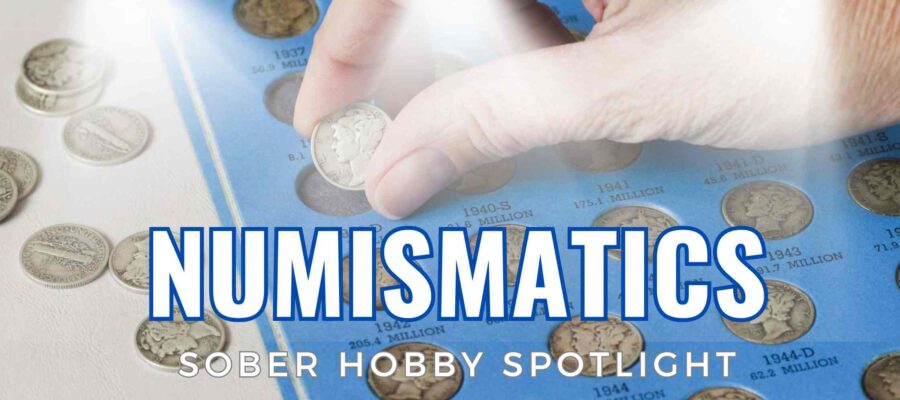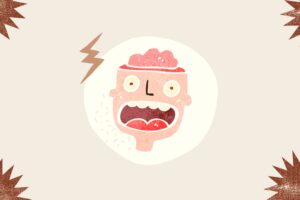I’ve written several blogs concerning sober hobbies. Occupying your mind (and hands) with something other than your addiction is of prime importance in early recovery and beyond. And while I’ve adopted and grown to love several sober hobbies (journaling, guitar, gardening, exercise, etc), none has grabbed my attention quite as much as Numismatics.
So, what is numismatics? To put it plainly, numismatics is the study or collecting of coins and paper currency. Tokens, medals, and scrip are considered exonumia, but I’ll save that for another post, since numismatics alone can (and has) literally filled hundreds of volumes on its own!

Silver, gold, copper, nickel, old, new, your numismatic options are endless
Why coin collecting? Why now? I (and my wife) ask that question all the time. It’s not like this is an entirely new thing for me. My first coin collection came into being like so many others, my grandfather passed away and I ended up with his collection (more on this later).
Over the years, I saved money from my trips to Europe, Russia, Mexico, and Canada. Whenever I found a cool coin in my change, I’d keep it. In the mid 1990’s when the U.S. Mint changed to large portraits of the presidents on paper money, I set some of the older bills aside. Here and there, friends and family gave me coins from their travels. Soon I had amassed a tiny treasury’s worth.
All of these coins and currency wound up in envelopes and boxes and stuffed away in the deep recesses of various closets and cabinets. Until recently…
The Budding Numismatist
A few months back, my daughter and I were cleaning out the garage. She found an old box full of loose change. Nothing earth shattering, just some run of the mill quarters, dimes, nickels, and pennies. Yet this box of coins fascinated her. She spent the next several hours meticulously counting, stacking, and organizing them.
The next day, she asked me if I had any more change. I ran upstairs and fetched another, much larger box of common coins from our bedroom closet. We spent the next several days sorting and organizing the hundreds of dollars contained therein. (Better than paying ransom to CoinStar, lol)
She was absolutely fascinated and I was drawn in. I had a brilliant idea and immediately proceeded to Ebay and ordered a ‘lot’ of old U.S. coins. It arrived within a few days. I went back through the coins we had previously organized. I grabbed a few large handfuls, and tossed those into yet a third box.
Into this box I mixed an assortment of Buffalo nickels, Mercury dimes, Lincoln wheat cents, and a Standing Liberty quarter or two from my Ebay purchase. I then rushed downstairs and announced that I had found another stash of coins. Hours more of sorting and ‘discovering’ all kinds of crazy cool old coins.
The next morning, I busted out my collection (including my grandfather’s coins) and we sorted that all out. My grandfather’s stuff ranged from old Confederate bills to money he collected in the Pacific during WWII while serving in the navy. Before long we both learned a new word: numismatics. And I had a budding numismatist on my hands. Actually, two.
Early Lessons In Numismatics
When I was a kid my favorite uncle used to say: “If you don’t take the time to learn about something, you’ll pay the tuition another way, and it’ll be far more expensive.” And I’ve come to learn his sage advice enough the hard way, that I endeavor to educate myself in advance of most new pursuits. But if I’m being honest, I wasn’t quite so diligent when it came to numismatics related purchases out of the gate.
If you don’t take the time to learn about something, you’ll pay the tuition another way, and it’ll be far more expensive.
– My favorite uncle
I think a lot of this had to do with my daughter getting older and the inevitable retirement of her favorite teddy bears and our wonderful 500 acre wood (of which I’ve written extensively) I saw coin collecting as a way to maintain our connection as she traversed middle school and beyond. In my excitement, I began buying coins and numismatic related items in earnest and often with little research.
Other than the ‘lots’ of assorted old coins from Ebay, I was buying coin albums on Amazon. We needed lots of coin rolls, sleeves, and coin books to organize the ‘sets’ we were building from our new found activity: coin roll hunting. This is where you go into a bank branch and withdraw rolls of quarters, dimes, nickels, pennies, and half dollars (this last denomination being notoriously difficult to acquire). Once home, you go through each roll looking for coins to add to your collection.
Our first ‘set’ (a coin set is a collection based on a theme) was U.S. state quarters, a very common place to start. This blossomed into National Park quarters, Lincoln wheat cents, Jefferson nickels, buffalo nickels, JFK half dollars, Morgan dollars, and more.
To the ‘raw’ coins we collected from bank rolls, we soon added ‘slabbed’ coins. Others were purchased from coin shops and antique stores.
Paying Tuition Makes One Smarter
It wasn’t long before all these purchases really started to add up. But fortunately, as we went, we began reading coin collecting books. We watched videos and we joined the American Numismatics Association and consumed mountains of excellent content on their site. We visited PCGS and NGC, and downloaded their apps (which we have come to rely on daily), and began learning how to grade coins. Additionally, we went to dozens of coin shops and shows and talked with dealers.
As we did these things, we soon learned we had made some common beginner mistakes and quickly adjusted course. Here’s a short list of what we learned so you can hopefully avoid these should you pursue numismatics:
- There are TONS of overpriced crap coins on the market. We know, we bought many.
- Buying plastic sleeves and tubes made with PVC can DAMAGE YOUR COINS. I had to replace a ton of these. Tuition paid, lesson learned!
- Read, read, read. The amount of money (tuition) spent on numismatics books will not only save you a ton of money on the aforementioned crap coins, but could actually make you A LOT of money (more on this later).
- Specialization really pays off. Learn as much as you can about a singular denomination and series. I really like Jefferson Nickels from 1938 to present. My daughter loves Ike dollars and JFK half dollars. I wouldn’t say either of us is an expert yet, but we’re learning at a furious pace.
- Form relationships with local coin dealers. They will teach you a lot and can help you secure hard to find coins.
- Buying from dealers and shows is way cheaper than buying online.
- Buying online is sometimes necessary if you’re looking for something specific.
There’s more, a lot more. Trying to keep it simple.
Funding A Numismatics Hobby
The wonderful thing about numismatics is that it doesn’t have to be expensive. Quite the contrary, in fact. One can start just as my daughter and I did by building sets of quarters from boxes of change tossed in the back of closet, a coffee can, or gallon wine jug.
You can then supplement this by coin roll hunting. If you go to your local branch and get five rolls of quarters, that’s $50 ($10/roll, 40 quarters/roll). If you only keep twelve quarters, that’s $3. You take the other $47 back to the bank and deposit it or exchange it for say twenty rolls of nickels and fourteen rolls of pennies (which equals $47). Mix and repeat.
The only other things you’ll need are some coin collecting albums/books, coin rolls, and a place to store everything (and if you’re like us, your collection will require a dedicated space).
We still coin roll hunt regularly, but have moved to acquiring coins that are rarely or never found through this approach. Still, this doesn’t have to be expensive as sets of low grade (but perfectly acceptable) coins are both inexpensive and abundant. Many commons coins are also available in high grades at reasonable prices.
It’s when you start to collect rarer coins in higher grades that prices move up rapidly and can become eye popping. For example, a 1943 D Lincoln penny that sold for $1,800,000 at auction!
Of course, most of us common folk don’t have that kind of coin (HA!) to spend on pennies, nickels, dimes, or quarters (or much else for that matter). Yet building a cool collection is attainable for anyone who is interested in numismatics.
Sober Investing Turns To Coins
My funding for our growing collection comes from the money I used to spend on marijuana and alcohol. In my Sobriety Portfolio blogs, I discuss my strategies for investing this ‘found money’ in stocks, ETFs, and other exchange traded assets.
After investing my sober financial savings in the stock market for one year, I shifted that investment into numismatics and bullion (gold, silver, platinum, palladium, etc). Taking all that I’ve learned from my deep dive study into the topic, I’ve managed to set up a numismatic portfolio that is trouncing the returns I’m seeing in the stock market.
For example, my Sober Stock portfolio has earned 24% and continues to received regular cash dividends which are reinvested. Not bad! Pretty damn good, actually!
But I’ve managed to earn 53% on my investments in coins by learning how to identify undergraded coins, errors, and varieties through specializing in pennies, nickels, half dollars, and Morgan dollars. For example, two days ago, I walked into a coin shop and bought two beautiful “mint state” Morgan dollars. The first was $41 and the second $42. They were slabbed and graded by a fourth tier grading service. I could see they were great coins, so I bought them both.
Upon arriving home, I ‘cracked’ them out of their holders and compared them to grading photos in my PCGS app. Coins similar to these were selling for upwards of $130 EACH! Suffice to say, I safely doubled my money and more on that transaction! And I’ve done this several other times both on Ebay and at coin shows, and am beginning to do this more consistently as my knowledge of coins and grading advances.
Coins And The Future
Now the previous section isn’t intended to come across as bragging. I’ve done nothing more than take the time to pay my tuition and educate myself (and continue to do so), so that now I’m in the position to profit from my knowledge. But nothing is 100%. I’ve bought some overpriced coins, too. And probably will again in the future. That goes with the territory! There will always be savvier sellers than me in the marketplace, but I’m consistently working to close the gap. And I’m more than happy to pay a fair price (which is most of the time), just not a grossly inflated one.
There’s talk at a national level of moving away from physical money and converting to a strictly digital currency. I can’t say when or if this transition will happen. If it does, the days of hunting rolls from your local bank branch will become a thing of the past. The only place to acquire coins in the age of digital dollars will be from a dealer or auction. Sad really since that’ll put collecting out of reach of many. And it eliminates the avenue by which most people get interested in collecting in the first place – finding that cool coin in your pocket change.
As far as my and my daughter’s future goes, numismatics shines bright. And since there are few females pursuing the hobby (much less professionally) this could be a wonderfully future proofed career path for her should she continue on with it.
For me, it’s a love of connecting with my daughter and all of the history and romance coins carry with them. I’ve learned that each coin has a story to tell and the twists and turns are endless.
I’m so happy she and I found this new connection. It’s a truly wonderful hobby full of history, intrigue, and treasure! Happy hunting!




